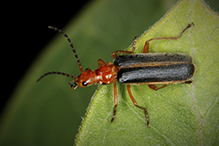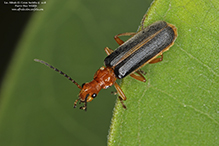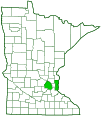downy leatherwing
(Podabrus tomentosus)
Conservation • Description • Habitat • Biology • Distribution • Taxonomy
Conservation Status |
|
|||||||
| IUCN Red List | not listed |
|||||||
| NatureServe | NNR - Unranked |
|||||||
| Minnesota | not listed |
|||||||
Description |
||
Downy leatherwing is a small to medium-sized soldier beetle. It occurs in the eastern United States east of the Great Plains and adjacent Canadian provinces. It was once common but has been declining in the last 50 years, probably due to the introduction of competing non-native species. It is rare in the southeast, uncommon in Canada, more common in the Midwest, and less common in Minnesota where it is at the western edge of its range. It is found from late June to mid-August in prairies and meadows. The body is soft, somewhat flattened, and elongated, ¼″ to ½″ (7 to 12 mm) long. The exoskeletal plate covering the thorax (pronotum) is wider than long but less than 1.5 times as wide as long. It is widest just beyond the middle, slightly narrower at the front (apex) than at the rear (base), and the sides are broadly curved (bowed) outward. It is straight across at the front and does not conceal the head. It is glossy, entirely orangish-red, and sparsely covered with moderately short hairs. It is also sparsely covered with minute punctures. The space between the punctures is greater than the size of the punctures. On each side near the middle there is a small, raised, pear-shaped projection (tubercle) pointing to the center of the rear margin. The wing covers (elytra) are black, leathery, flexible, 2.3 times as long as wide, almost 5 times as long as the pronotum, and completely cover the abdomen. They are almost parallel near the base, slightly and evenly tapered in the middle, and broadly rounded at the tip. The outer margins and the inner (sutural) margin are often orange. The surface is rough, covered with minute punctures, and densely covered with long, fine, gray hairs. The plate between the wing bases (scutellum) is well developed and visible but small and orangish-red. The head is orangish-red. In front of the eyes it is wider than long. It narrows behind the eyes forming a distinct “neck” that is visible from above, not hidden by the pronotum. The edges of the collar-like plate wrapping around the head (postocciput) merge into a single closed suture (gular suture) on the throat. The face is orange. The plate on the lower face (clypeus) is sometimes dark brown. The compound eyes are small and black. The antennae have 11 segments. The first two segments are entirely orangish-red. The remaining segments are usually black with orange just at the base. The amount of orange is variable, and sometimes the segments are mostly orange with black just at the tip. The third segment is longer than the second. The legs are long and slender. The third segment (femur) of each leg is orange. The fourth segment (tibia) may be entirely orange or orange just at the base becoming dark brown toward the tip. The end part of each leg (tarsus), corresponding to the foot, has 5 segments and may be dark brown or orange. On both sexes the claw at the end of the tarsus is broadly cleft and has a long narrowly angled tooth. |
||
Size |
||
Total length: ¼″ to ½″ |
||
Similar Species |
||
Habitat |
||
Prairies and meadows |
||
Biology |
||
Season |
||
Late June to mid-August |
||
Behavior |
||
|
||
Life Cycle |
||
|
||
Larva Food |
||
Larvae overwinter in the ground. |
||
Adult Food |
||
Aphids and other small, soft-bodied insects |
||
Distribution |
||||
|
Sources |
|||
| 11/15/2018 | ||||
Occurrence |
||||
Once common but now declining |
||||
Taxonomy |
|||
Order |
Coleoptera (beetles) | ||
Suborder |
Polyphaga (water, rove, scarab, long-horned, leaf, and snout beetles) | ||
Infraorder |
Elateriformia | ||
Superfamily |
Elateroidea (click, firefly and soldier beetles) | ||
Family |
Cantharidae (soldier beetles) | ||
Subfamily |
Cantharinae | ||
Tribe |
Podabrini | ||
Genus |
Podabrus | ||
Synonyms |
|||
|
|||
Common Names |
|||
This species has no common name. The common name of the family Cantharidae is soldier beetles, and it is applied here for convenience. |
|||
Glossary
Clypeus
On insects, a hardened plate on the face above the upper lip (labrum).
Elytra
The hardened or leathery forewings of beetles used to protect the fragile hindwings, which are used for flying. Singular: elytron.
Femur
On insects and arachnids, the third, largest, most robust segment of the leg, coming immediately before the tibia. On humans, the thigh bone.
Pronotum
The exoskeletal plate on the upper side of the first segment of the thorax of an insect.
Scutellum
The exoskeletal plate covering the rearward (posterior) part of the middle segment of the thorax in some insects. In Coleoptera, Hemiptera, and Homoptera, the dorsal, often triangular plate behind the pronotum and between the bases of the front wings. In Diptera, the exoskeletal plate between the abdomen and the thorax.
Tarsus
On insects, the last two to five subdivisions of the leg, attached to the tibia; the foot. On spiders, the last segment of the leg. Plural: tarsi.
Tibia
The fourth segment of an insect leg, after the femur and before the tarsus (foot).
Visitor Photos |
|||||
Share your photo of this insect. |
|||||
| This button not working for you? Simply email us at info@MinnesotaSeasons.com. Attach one or more photos and, if you like, a caption. |
|||||
Alfredo Colon |
|||||
 |
 |
||||
MinnesotaSeasons.com Photos |
|||||
|
|||||

Slideshows |
||

Visitor Videos |
|||
Share your video of this insect. |
|||
| This button not working for you? Simply email us at info@MinnesotaSeasons.com. Attach a video, a YouTube link, or a cloud storage link. |
|||
Other Videos |
|||

Created 11/15/2018
Last Updated:


